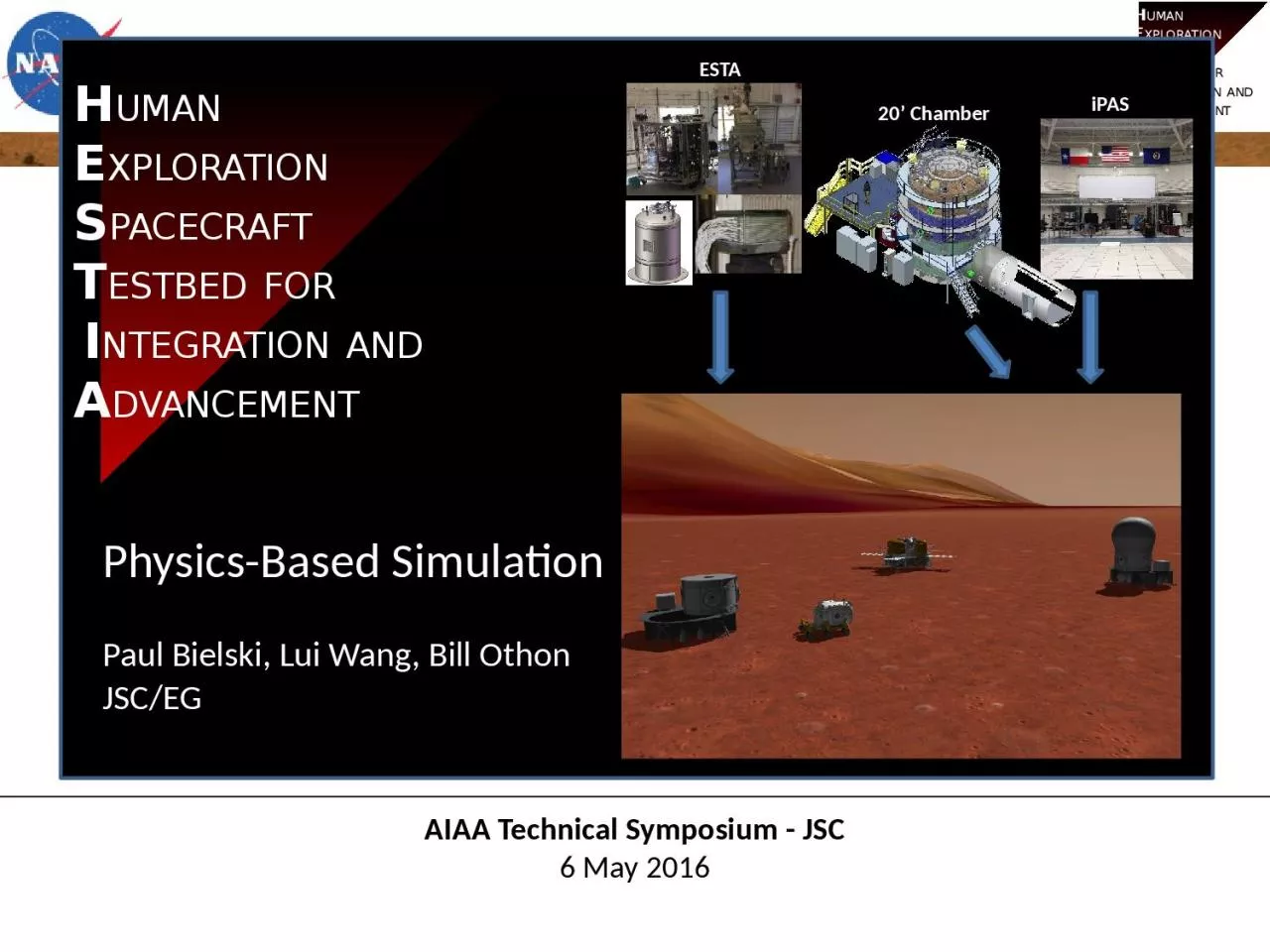

6 May 2016 H uman E xploration S pacecraft T estbed for I ntegration and A dvancement Picture of ESTA ESTA 20 Chamber iPAS PhysicsBased Simulation Paul Bielski ID: 1000731
Download Presentation The PPT/PDF document "AIAA Technical Symposium - JSC" is the property of its rightful owner. Permission is granted to download and print the materials on this web site for personal, non-commercial use only, and to display it on your personal computer provided you do not modify the materials and that you retain all copyright notices contained in the materials. By downloading content from our website, you accept the terms of this agreement.
1. AIAA Technical Symposium - JSC6 May 2016HumanExplorationSpacecraftTestbed for Integration andAdvancementPicture of ESTAESTA20’ ChamberiPASPhysics-Based SimulationPaul Bielski, Lui Wang, Bill OthonJSC/EG
2. NASA doesn’t get access to Exploration Mission Environment oftenSimulation is required to develop, test, and operate spacecraftEvaluate the coupled effects of the environment, the vehicle configurations, and crew activities as vehicles evolve throughout their life cyclesProvide insight to project systems engineers and subsystem teams on the integrated effects of design selectionsAssess performance of hardware and software in environments and conditions that are expensive or impossible to recreate on the groundHow Do We Design for Mars?Integrated Simulation allows early analysis of Emergent Properties of spacecraft
3. Types of SimulationsAnalysisSingle or multiple subsystem simulations that provide insight into vehicle design or operation, running on an engineer’s desktopRobotics, GN&C, Mechanisms, Power, Thermal, Life SupportHardware-in-the-loop SystemsSingle or multiple subsystem simulation supplying a realistic environment to one or more hardware elements for analysis, testing, software development, or software verification purposesRobotics, Avionics, GN&CHuman-in-the-loop SystemsFull team, single system, or scenario training in dedicated facilities with representations of crew and flight controller interfaces used for training and procedure verificationRobotics, Avionics, GN&C, Mechanisms, Power, Thermal, Life SupportMany simulations cross these boundariesBegin life for analysis, and end up being used for hardware- or human-in-the-loop activitiesA given simulation may be used throughout a program life cycle3
4. Analysis Simulations4Mobile Servicing System (MSS) sim - ISS robotics
5. Hardware in the Loop5Six Degree of Freedom Dynamic Test System (SDTS) – Stewart platform used to validate docking and berthing mechanisms
6. Human-in-the-Loop Simulation6Systems Engineering Simulator (SES) – Real-time, crew-in-the-loop simulation of the dynamic flight phases of Shuttle, ISS, Orion, and future vehicles
7. Integrated Vehicle Simulation Tools7Trick simulation environment provides model execution ordering, input processing, state integration, data recording, and post-processing capabilitiesJSC Engineering Orbital Dynamics (JEOD) provides environment models and 6-DOF dynamicsGeneral Use Nodal Network Solver (GUNNS) provides physics-based models of power, fluidic, and thermal systemsMultibody Dynamics (MBDyn) provides kinematic and dynamic modeling of complex mechanisms including robotsPong and MechDyn provide modeling of complex contact surfaces, including terrain and mechanismsTrickHLA provides IEEE 1516 High Level Architecture (HLA) interface mechanism for all Trick simulationsEDGE provides realtime graphics rendering capabilitiesDevelop a reusable set of tools, used by multiple NASA projects
8. Environment Modeling (and cool Graphics!)8Simulation, not Animation
9. Vehicle Subsystems Modeling9GUNNS provides a common design and code generation development approach to three “aspects”Fluidic (plumbing, life support systems, thermal control)Electrical (generation, distribution, loads)Thermal (structure temperatures, solar heating, albedo)Data-driven component models are developed once and reused across modeled subsystem designs
10. Simulation through the Project Life Cycle10Producing simulations early in the development phase allows leverage of the investment throughout the life cycleSimulation supports early design evaluation, with better accuracyModel fidelity improves with design maturity and test resultsSimulation support Flight Software verification and testSimulation supports Hardware in the Loop, Spacecraft V&VSupports operator training pre-flightUltimately can support crews in mission environmentLong comm delayLoss-of-comm
11. Design, Analysis, and Test11Source: Lydia Davis/JSC
12. Future of Model Based Methods12Establish Iterative Loop Between Design, Analysis and Test